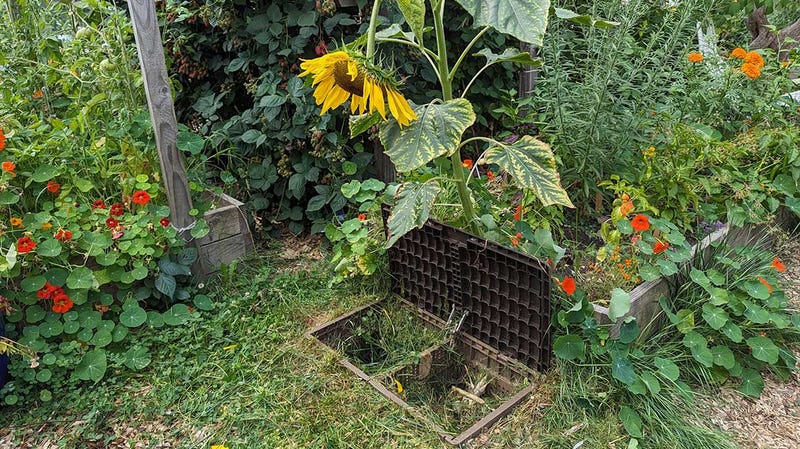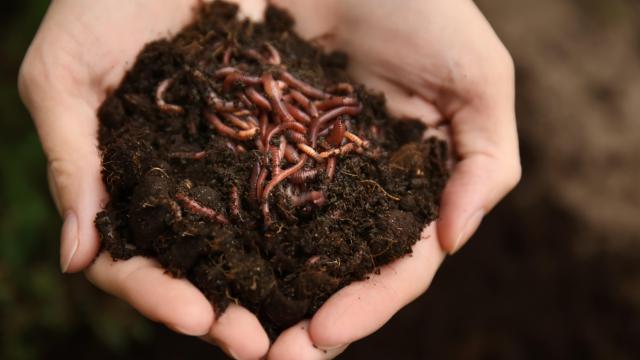Composting has an ick factor. Between gardening and cooking, I produce a lot of waste that goes right into the ‘green bin’ for city composting, and I’m always super happy to shuffle it to the curb and out of my house. I’d always wanted to compost more seriously, but lacked the room, was fearful of pests, and mostly, just didn’t have a lot of faith in how long it would take for as little output as I’d get. I am totally uninterested in countertop “composters” that just incinerate your waste rather than make real compost.
I used to halfheartedly fill a tumbler composter, and then forget about it, in a corner of the yard. It sat next to the worm tower I’d been gifted, which was empty. The worms had gotten way too hot in the summer, too cold in the winter, and I was not prepared to bring the worms indoors for the extreme weather. I felt strongly the worms had their territory and I had mine, and they were best kept separate.
Adding worms to your composting speeds it up 100x
Still, I loved the idea of vermicomposting (composting with worms), mostly because of the speed at which they processed compost. It didn’t require high heats or constant turning over and balancing with “browns.”
I kept seeing ads for the SubPod. Since I can’t help but be me, I didn’t want to spend the money—so instead, I built a similar structure made out of some wood boxes, which I buried in a grave-sized hole in the ground, and I bought some red wrigglers. And for a whole season, I would put my food waste and garden cuttings in the composter, and let the worms go at it. I could not get over how efficient the worms were, just ploughing through the food. I was constantly pulling incredibly good-looking, rich, dark compost out to put in my boxes.
The trouble was the wood, which after a season underground, was becoming part of the compost through decomposition. But I understood, at that point, that the process worked, so it was time to bite the bullet and get a SubPod.

Plastic composting boxes don’t decompose
A SubPod works much like a storage bench with flip up seating±but instead of storing BBQ tools, you’re storing compost and worms. Inside are two storage chambers. You add your waste to one side, and when it’s full, you use the other. When you’re not filling the pod, you put the lid down. The box portion has holes everywhere for the worms to go in and out of. You are supposed to bury most of the box in soil, leaving the top two inches above the soil line, for air flow.
In a lot of the promotional material for SubPod, you see it buried in a raised bed, so it acts like a bench. You just don’t realize that sitting under you are thousands of worms. I went ahead and buried it in the ground, so it would have great insulation for summer and winter.
Even if worms gross you out, you’ll come to appreciate them
Because the SubPod was buried in the ground and my soil is very healthy and chock full of worms, I didn’t bother to purchase worms; I knew they’d find the composter on their own. But you can get them from places like Uncle Jim’s Worm Farm if you lack this confidence. They come in a bag, and it’s worth noting that I have never, not once, had to touch an actual worm. You upend the bag and dump the worms in. As worms go, red wrigglers are pretty innocuous.
The thing is, as much as worms generally give me the heeby jeebies, I have developed an immense affection for my compost worms. The sheer amount of work they do is impressive. So much so that when people come over to grab worms (like sourdough starters, you can share your small wriggly friends to start in your friend’s compost), I insist on only opening the lid before 10:00 am or after 6:00 pm, so I don’t shock the worms with the intense sunlight or heat. I feel really responsible for my worms. If I don’t give them compost to process, they’ll just leave the composter and go find food elsewhere, but I am always a little self-satisfied when I bring them food of my own.
How to get your SubPod started
Your pod comes with the plastic box, which is easy to set up. It also comes with some natural fibre mats that go into each of the pod compartments. You put the food waste under them, and they insulate the food a bit. Over time, the worms will compost them, too. While you can buy new ones, I’ve generally found them unnecessary. At worst, I throw some damp paper bags or newspaper on top, but mostly I just leave the box shut during the hottest part of the day.
Like all compost, you want to maintain a balance of wet green and dry brown material, but it’s just not as complicated as I had expected. The worms do a lot of balancing. Your brown materials, like paper, dry leaves or branches, balance the stuff from your kitchen. With worms, you want to take an extra step–worms don’t like citrus, garlic or onions. In fact, they don’t love spicy foods, either, so you try to use them in small amounts. That stuff can go into your city compost. Generally, I get my still lawn-mowing neighbour to dump a basket of grass clippings next to the composter and wait for it to dry out, and then use it as my brown material as needed.
You can turn your compost, and I find it helpful to do so, so I got an aerator to do it that hangs nearby. The thing that separates this from regular composting is that it just takes so much less time. My worms make a week’s worth of waste into compost in about ten days. Within sixty days, I have an entire bin full of compost ready to go.
You can sift it, using a compost sifter, but I don’t bother. The larger particles can continue to compost in place wherever they go.
SubPod has expanded to come in a bunch of sizes for smaller spaces like apartment balconies, which seems useful. The worms and I are in our fourth year together, and honestly, we’re pretty happy.

Leave a Reply
You must be logged in to post a comment.